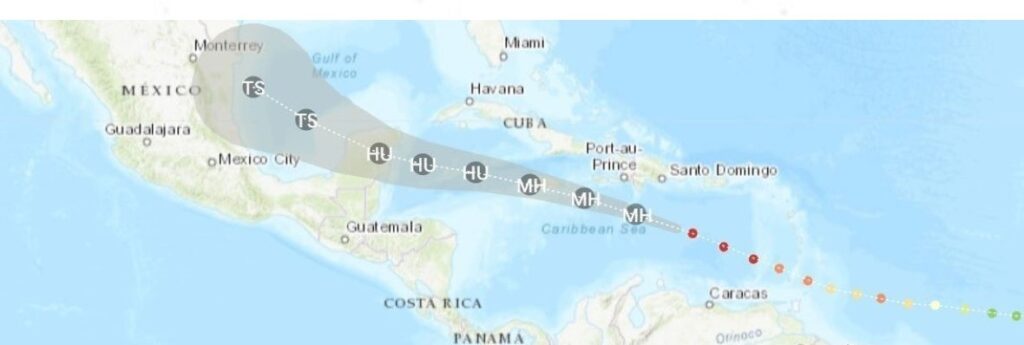Hurricane Beryl’s explosive growth early into an unprecedented early whopper of a storm – one that started in the southern Caribbean and looped its way over the course of about 10 days through Mexico and all the way back (albeit in diminished form) to eastern Canada – shows the literal hot water the Atlantic and Caribbean are in right now – and the kind of season ahead, experts say.
The storm left devastation in its wake across the Caribbean, Mexico and the US, blowing away multiple records even before its major-hurricane-level winds approached land.
The powerful storm acted more like monsters that form in the peak of hurricane season thanks mostly to water temperatures as hot or hotter than the region normally gets in September, according to several hurricane experts.
Beryl set the record for earliest Category 4 with winds of at least 209 kph – the first-ever Category 4 in June. It also was the earliest storm to rapidly intensify with wind speeds jumping 102 kph in 24 hours, going from an unnamed depression to a Category 4 in 48 hours.
On July 1, it strengthened to a Category 5, becoming the earliest hurricane of that strength observed in the Atlantic basin on record, and only the second Category 5 hurricane in July after Hurricane Emily in 2005, the US National Hurricane Center said. Category 5 storms have winds exceeding 250 kph.
Beryl followed an unusually southern path, especially for a major hurricane, said University at Albany atmospheric scientist Kristen Corbosiero. It made landfall July 1 on the island of Carriacou with winds of up to 240 kph, and plowed through the islands of the southeast Caribbean, heading west towards Mexico, and ultimately pummeling Texas before drenching parts of the US and even Canada.
“Beryl is unprecedentedly strange,” said Weather Underground co-founder Jeff Masters, a former government hurricane meteorologist who flew into storms. “It is so far outside the climatology that you look at it and you say, ‘How did this happen in June?’”
Get used to it. Forecasters predicted months ago it was going to be a nasty year and now they are comparing it to record busy 1933 and deadly 2005 – the year of Katrina, Rita, Wilma and Dennis.
“This is the type of storm that we expect this year, these outlier things that happen when and where they shouldn’t,” University of Miami tropical weather researcher Brian McNoldy said. “Not only for things to form and intensify and reach higher intensities, but increase the likelihood of rapid intensification. All of that is just coming together right now, and this won’t be the last time.”
Colorado State University hurricane researcher Phil Klotzbach called Beryl “a harbinger potentially of more interesting stuff coming down the pike. Not that Beryl isn’t interesting in and of itself, but even more potential threats and more – and not just a one off – maybe several of these kinds of storms coming down later.”
The water temperature around Beryl is about 1 to 2 degrees Celsius above normal at 29 Celsius, which “is great if you are a hurricane,” Klotzbach said.
Warm water acts as fuel for the thunderstorms and clouds that form hurricanes. The warmer the water and thus the air at the bottom of the storm, the better the chance it will rise higher in the atmosphere and create deeper thunderstorms, said the University at Albany’s Corbosiero.
Sea surface temperatures in the Atlantic and Caribbean “are above what the average September (peak season) temperature should be looking at the last 30-year average,” Masters said.
It’s not just hot water at the surface that matters. The ocean heat content – which measures deeper water that storms need to keep powering up – is way beyond record levels for this time of year and at what the September peak should be, McNoldy said.
“So, when you get all that heat energy you can expect some fireworks,” Masters said.
This year, there’s also a significant difference between water temperature and upper air temperature throughout the tropics.
The greater that difference is, the more likely it becomes that storms will form and get bigger, said MIT hurricane expert Kerry Emanuel. “The Atlantic relative to the rest of the tropics is as warm as I’ve seen,” he said.
Atlantic waters have been unusually hot since March 2023 and record warm since April 2023. Klotzbach said a high-pressure system that normally sets up cooling trade winds collapsed then and hasn’t returned.
Corbosiero said scientists are debating what exactly climate change does to hurricanes, but have come to an agreement that it makes them more prone to rapidly intensifying, as Beryl did, and increases the strongest storms, like Beryl.
“This is sort of our worst scenario,” she said. “We’re starting early, some very severe storms. .. Unfortunately, it seems like it’s playing out the way we anticipated.”

